Advertisements
Advertisements
प्रश्न
Twelve wires, each of equal resistance r, are joined to form a cube, as shown in the figure. Find the equivalent resistance between the diagonally-opposite points a and f.

उत्तर
Let V be the potential difference between the points a and f. Let current i enter a and leave from f. The distribution of current in various branches is shown in figure.
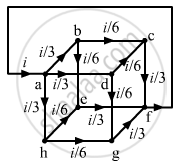
To calculate the potential difference between a and f, consider the path abcf and apply Kirchofff's Law:-
\[\frac{i}{3}r + \frac{i}{6}r + \frac{i}{3}r = V\]
\[\Rightarrow \left( \frac{2ir}{3} + \frac{ir}{6} \right) = V\]
\[ \Rightarrow \left( \frac{5ir}{6} \right) = V\]
The effective resistance between a and f,
\[R_{eff} = \frac{V}{i} = \frac{5}{6}r\]
APPEARS IN
संबंधित प्रश्न
The current is drawn from a cell of emf E and internal resistance r connected to the network of resistors each of resistance r as shown in the figure. Obtain the expression for
- the current draw from the cell and
- the power consumed in the network.
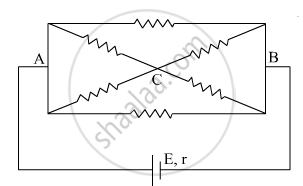
ε1 and ε2 are two batteries having emf of 34V and 10V respectively and internal resistance of 1Ω and 2Ω respectively. They are connected as shown in the figure below. Using Kirchhoff’s Laws of electrical networks, calculate the currents I1 and I2.

Given the resistances of 1 Ω, 2 Ω, 3 Ω, how will be combine them to get an equivalent resistance of (6/11) Ω?
Determine the equivalent resistance of networks shown in Fig.

Consider the following two statements:-
(A) Kirchhoff's junction law follows from conservation of charge.
(B) Kirchhoff's loop law follows from conservative nature of electric field.
Find the circuit in the three resistors shown in the figure.
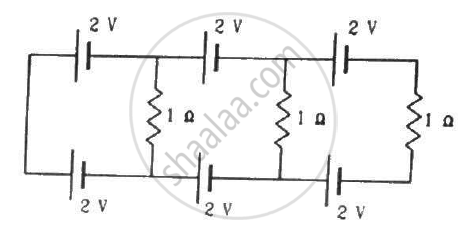
Consider the circuit shown in the figure. Find (a) the current in the circuit (b) the potential drop across the 5 Ω resistor (c) the potential drop across the 10 Ω resistor (d) Answer the parts (a), (b) and (c) with reference to the figure.
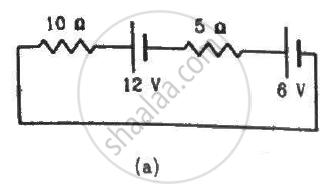
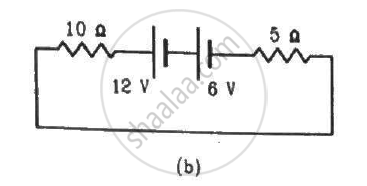
State Kirchhoff ’s voltage rule.
State the principle of potentiometer.
The instrument for the accurate measurement of the e.m.f of a cell is ______.
The Kirchhoff's second law (ΣiR = ΣE), where the symbols have their usual meanings, is based on ______.
Two cell of 1.25 V and 0.75 V are connected parallel. The effective voltage will be:-
The e.m.f of The battery in a thermocouple is doubled. The rate of heat generated at one of the junction will.
Three resistors having resistances r1, r2 and r3 are connected as shown in the given circuit. The ratio `i_3/i_1` of currents in terms of resistances used in the circuit is: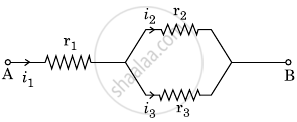
Why are alloys used for making standard resistance coils?
State the two Kirchhoff’s rules used in the analysis of electric circuits and explain them.
The figure below shows two batteries, E1 and E2, having emfs of 18V and 10V and internal resistances of 1 Ω and 2 Ω, respectively. W1, W2 and W3 are uniform metallic wires AC, FD and BE having resistances of 8 Ω, 6 Ω and 10 Ω respectively. B and E are midpoints of the wires W1 and W2. Using Kirchhoff's laws of electrical circuits, calculate the current flowing in the wire W3:

